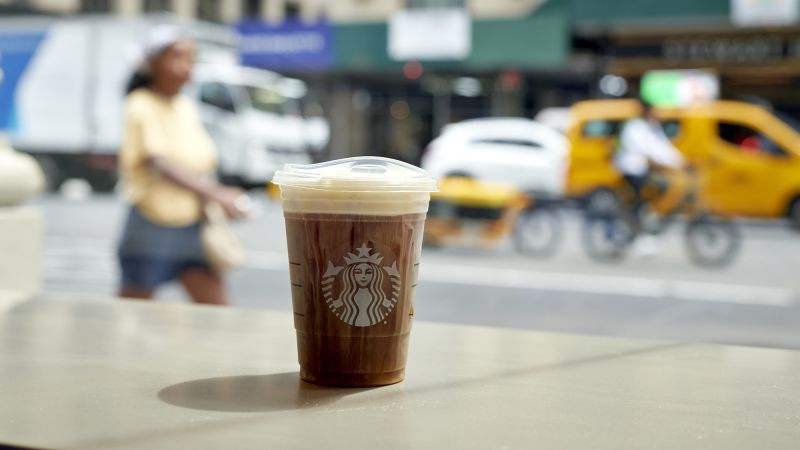Extra shots, cold foam, oat milk and sugary syrups — coffee snobs might turn their noses up at Starbucks’ custom, often wildly indulgent, lattes and cappuccinos. But they’re turning into big business for the company.
High-priced lattes and customized drinks helped lift the coffee chain’s US sales in the quarter ending on October 1, the company said Thursday.
In North America, sales at Starbucks-operated stores open at least 13 months jumped 8% in the quarter, driven mostly by people spending more per visit.
“Our customers continue to favor more premium beverages,” CFO Rachel Ruggeri said during an analyst call discussing the company’s results Thursday. Customers are also coming in more often and adding food to orders, said Ruggeri, who also cited higher prices as part of the growth.
While custom drink orders have always been possible at Starbucks, the arms race of recipes and flavors have been accelerated by social media, where off-menu drinks go viral. Starbucks has accordingly begun to experiment with selling these high-octane drinks itself, and it pays attention to how customers adjust beverages when ordering in cafés and develops recipes based on those preferences.
When it rolled out its new slate of fall drinks earlier this year, including its signature Pumpkin Spice Latte, it also introduced an Iced Pumpkin Cream Chai Tea Latte. That one “was inspired by a popular customer and barista customization,” the company said.
The more changes customers make to their drinks, the more they spend.
This year’s autumn drinks did particularly well, said CEO Laxman Narasimhan during Thursday’s call.
“We had a remarkable fall launch that led to record-breaking average weekly sales,” he said. “As customer demands have evolved, we’ve delivered more beverages, food and personalization and customization… to meet their expectations and grow the business.”
Total company revenue rose 11% in the fourth quarter, year over year, hitting a record $9.4 billion. For the full fiscal year, revenue grew 12% for a record of $36 billion. The company also reported revenue increases in China, a key growth market, which has been rebounding from Covid-related closures. Starbucks’ financial results beat Wall Street’s expectations. Shares of the company jumped 10% during the day and have remained essentially flat after the bell.
Demand stays strong, despite larger trends
But as Starbucks customers are shelling out more for ever-more elaborate drinks, other consumers are pulling back.
Taco Bell said this week that it is seeing growth in order numbers across demographics, thanks to its value deals and because customers are trading down from more expensive options. Denny’s, on the other hand, said it believes it is losing some business to fast food restaurants, and McDonald’s noted an industry-wide weakness when it comes to low-income customers.
Narasimhan said that when it comes to Starbucks, “we’re not really seeing any change in the sentiment in our customer base at this time,” emphasizing that “customer demand for us remains strong.”
Starbucks, he said, is benefiting from customers’ loyalty and their commitment to their routine, among other things. Still, he added, “we, of course, watch all of this extremely carefully.”
More food and smaller stores
During an investor update on Thursday afternoon, Narasimhan and other Starbucks executives provided an update on the company’s growth plan — including product innovation that relies on seeing what customers are ordering.
“We use analytics to discover what’s trending and then amplify those ideas with customers,” said Brady Brewer, the company’s chief marketing officer, adding that this approach helps keep the company’s products relevant. Brewer also said that Starbucks plans to add more snacks throughout the day, to help boost afternoon sales.
The company also plans to build more stores with different formats, including drive-thru only and delivery-only locations.
Today, “stores are at times packed, which doesn’t always create the best experience,” said Sara Trilling, president of Starbucks North America. New stores could help ease the burden on locations serving mobile, in-person and sometimes drive-thru orders. The company said it still has room to add more locations in the United States. Globally, it wants to hit 55,000 locations by 2030.
Operational improvements will also help relieve the pressure on stores, she said. The company has been rolling out new equipment to stores to make it easier for baristas to make drinks quickly.
Tech partnerships and corporate savings
During Thursday’s event, Starbucks said that it has a goal of doubling its digital rewards members over the next five years. Today, it has about 75 million active rewards members.
Brewer said it was a “big goal” but added that the company is already on track to achieve it. Rewards members spend more and come to Starbucks more often, he said.
The company is also extending its partnership with Microsoft to use AI to help it develop products, working with Apple on a so-called innovation store that will experiment with new technology, and using Amazon’s “just walk out” technology to think about new store layouts. Amazon and Starbucks have partnered on similar locations in the past.
Starbucks also said that it wants to save $3 billion over three years, including a $2 billion reduction in cost of goods sold, an accounting term that refers to how much companies pay for the products they sell. Some savings will come from reducing food waste, Ruggeri said.
In addition to saving money for the company, Starbucks said it plans to pay its employees more, both through higher wages and more hours.
Starbucks first unveiled a version of this growth plan last year, when Howard Schultz was interim CEO. A big feature of that plan included offering new perks and benefits to Starbucks employees — seen as a way to dissuade them from joining the growing unionization effort.
Starbucks announced in September of this year that Howard Schultz was stepping down from its board of directors. He now holds the title of “lifelong Chairman Emeritus.”
Read the full article here
